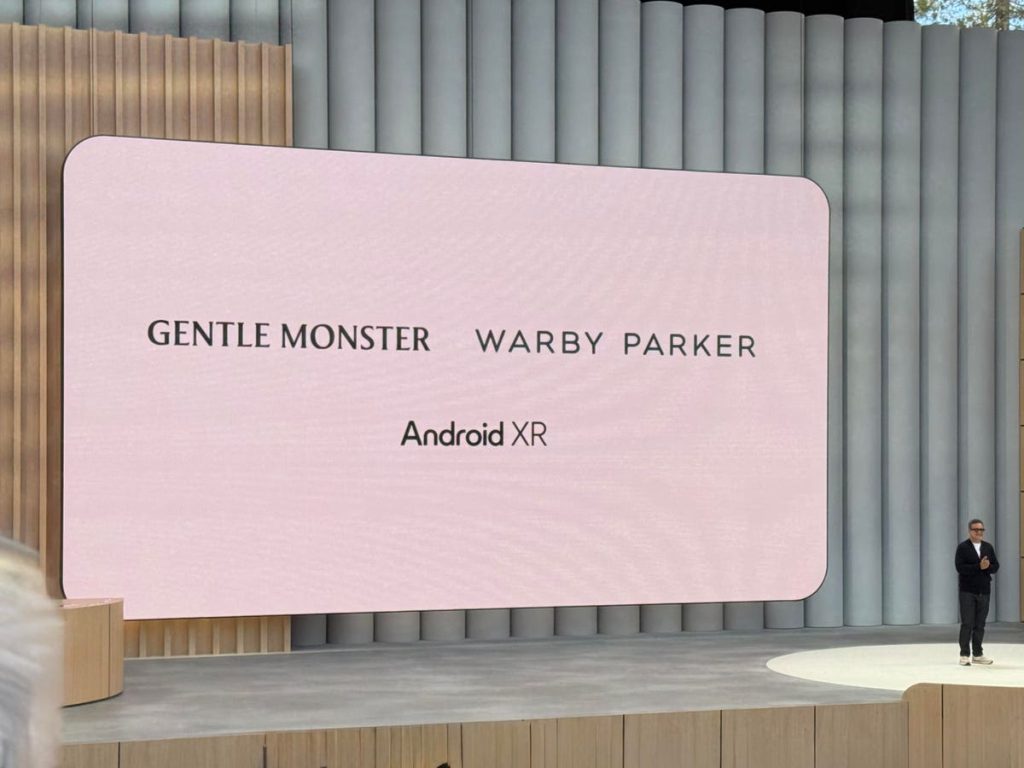Google I/O 2025
Alex Levin
Google announces Gentle Monster and Warby Parker as inaugural design partners for its new Android XR smart glasses, positioning itself against Meta’s Luxottica-powered eyewear and Apple’s design-led wearable strategy.
At its I/O 2025 conference, Google confirmed that its newly revealed Android XR platform will first appear in frames from Gentle Monster and Warby Parker. This development marks a significant progression in the smart glasses landscape, moving beyond early iterations like Google Glass.
2012: Google co-founder Sergey Brin, and designers Diane Von Furstenberg and Yvan Mispelaere walk … More
Getty Images for Mercedes-Benz
The original Google Glass project, despite its innovative spirit, encountered various factors that impacted its market acceptance and public perception. In stark contrast, the widespread adoption of Ray-Ban Meta smart glasses highlights a clear demand for wearable technology when integrated discreetly into everyday accessories. This points to a deliberate shift towards subtle technology, echoing the “quiet luxury” trend seen in high-end design – where sophistication lies in understated elegance, not overt display.
Android XR: Technology as Enhancement
Samsung’s Project Moohan
Xinhua News Agency via Getty Images
The Android XR platform is built to deliver advanced digital experiences directly into your line of sight. Google outlined four main categories for devices that Android XR will power: video-see through headsets such as Samsung’s upcoming Project Moohan, a spatial computing device; optical see-through headsets, including Xreal’s newly announced Project Aura and devices similar to what Meta showcased with Project Orion at Connect 2024; dedicated AR glasses, which Google itself demonstrated during this year’s I/O; and AI glasses, exemplified by the Ray-Ban Meta smart glasses.
Android XR Ecosystem outlined during Google I/O 2025
Alex Levin
While the debut in eyewear from Gentle Monster and Warby Parker underscores an emphasis on unobtrusive technology integration, this broader vision signals Google’s intent to cover a spectrum of extended reality experiences. The idea for the eyewear is for the technology to subtly enhance your daily life and interactions, becoming an intelligent layer that complements your vision, rather than drawing attention to itself.
Strategic Brand Alliances in a Competitive Market
The selection of these two brands for this partnership offers insight into Google’s strategic considerations. Meta’s smart glasses initiative benefited from its collaboration with Luxottica, a dominant force in the eyewear industry. Luxottica’s extensive portfolio includes iconic brands like Ray-Ban and Oakley, as well as luxury names such as Persol and Oliver Peoples, and licensed designer brands including Giorgio Armani, Chanel, Prada, Burberry, and Versace. Meta is also reportedly expanding its smart eyewear strategy into the sports and fitness sector, with plans to launch Oakley-branded smart glasses for athletes. This upcoming “Supernova 2” project, as reported, is expected to feature a center-mounted camera optimized for cyclists and athletes, a departure from the Ray-Ban model’s side-mounted design. The strong sales performance of Ray-Ban Meta glasses in various markets, even without advanced AI features, signals a significant existing demand for connected eyewear. These developments suggest a broader industry trend of technology companies diversifying their wearable offerings and targeting specific consumer segments, like athletes, to drive mainstream adoption.
Ray-Ban Meta
AFP via Getty Images
Apple, a company widely recognized for its strong design-led approach and a meticulous focus on user experience, has a history of strategic collaborations that extend beyond pure technology into the realm of luxury and high fashion. A notable example is its long-standing partnership with Hermès, which has resulted in exclusive and premium Apple Watch bands. These collaborations often blend Apple’s technological innovation with the artisanal craftsmanship and brand prestige of high-end fashion houses. Furthermore, Apple has actively brought in talent with experience in high fashion, suggesting a deliberate strategy to infuse design sensibilities from that sector into its product development. This deep-rooted appreciation for aesthetics and premium branding positions Apple uniquely in the smart eyewear market.
September 7, 2016 Apple Event announcing Apple Watch Series 2 Hermes edition
San Francisco Chronicle via Getty Images
The existence of Apple’s smart glasses project, while long rumored, gained clearer confirmation through recent reports. A new leak, indicates that Apple is developing specific chips for smart glasses. This development suggests Apple is ramping up work on such a device, designed to compete with popular offerings like the Ray-Ban Meta spectacles. The processor for these smart glasses is reportedly based on energy-efficient chips used in the Apple Watch, customized for power efficiency and to control the multiple cameras planned for the glasses. This move signifies Apple’s quiet progression in the smart eyewear space.
It is also worth noting that Gentle Monster has prior experience in collaborating with technology companies on smart eyewear. In November 2020, Gentle Monster partnered with Huawei on its “Eyewear 2” smart glasses. These earlier iterations focused on audio integration within the frames, aiming to provide a seamless earphone experience. While that product had a different technological scope, Gentle Monster’s participation in such ventures indicates an ongoing engagement with integrating technology into their design-forward frames.
Google’s choice of Gentle Monster and Warby Parker reflects a different, yet distinct, brand strategy. Gentle Monster is known for its avant-garde designs and position in the fashion-forward segment of the eyewear market. Warby Parker gained prominence through its direct-to-consumer model and accessible, design-conscious frames. This pairing suggests an effort to appeal to diverse segments of the eyewear market, both premium and accessible, while maintaining a focus on distinctive design.
Feed from Android XR Glasses, shown at Google I/O 2025
Alex Levin
The Future of Wearables: Design-Led Integration
The collaboration signals a continuation of the trend where technology companies partner with established fashion and lifestyle brands to bring new wearable devices to market. This strategy appears to prioritize industrial design and brand appeal as key factors in the adoption of smart glasses and other “wearables,” a term that has re-emerged in the context of these integrated devices. The goal is to embed digital functionality within eyewear in a manner that blends with contemporary style, aiming for a less conspicuous technological presence.

